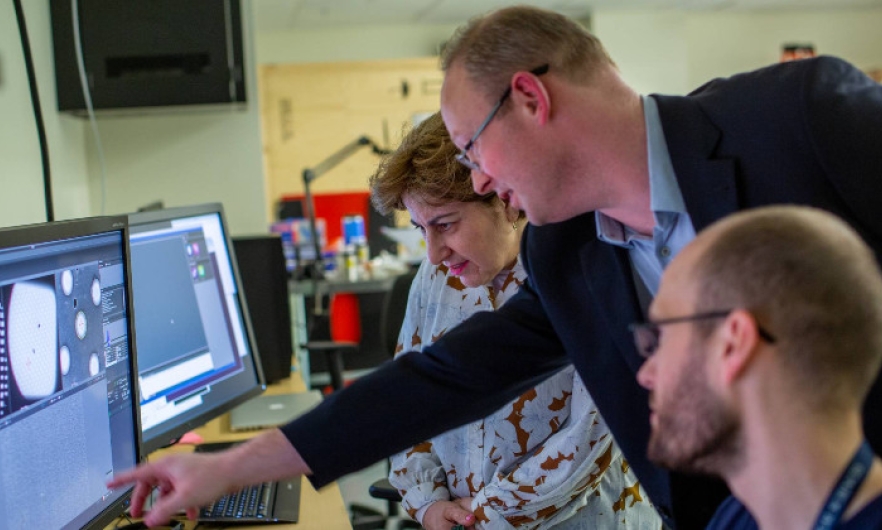BMB Associate Professor Receives Walder Foundation Gift
One of foundation's Science Innovation gifts will support Bailey lab cryo-EM work to understand CRISPR

Elizabeth Walder (left), of the Walder Foundation toured Biochemistry and Molecular Biology Associate Professor Scott Bailey’s laboratory and Johns Hopkins University research facilities in July 2019. Here she joins Bailey (center) in examining cryo-EM grid images with Department of Biophysics and Biophysical Chemistry postdoctoral fellow Evan Worden.
The Walder Foundation has selected Biochemistry and Molecular Biology Associate Professor Scott Bailey’s laboratory as one of its recipients in the area of Science Innovation. The Bailey lab investigates CRISPR systems, and the Walder Foundation’s gift will provide $1 million over five years to support the use of cryo-electron microscopy to determine the structures of molecules involved in those systems.
Bacteria use CRISPR, or Clustered Regularly Interspaced Short Palindromic Repeats, as an immune system to defend against infection, by identifying and destroying foreign DNA from viruses. CRISPR is often in the news for its use in gene editing, but Bailey’s research focuses on understanding how the system works – which can provide insights into protein-DNA interactions and provide the knowledge to further develop CRISPR tools.
The Walder Foundation gift will support capacity building in Bailey’s lab and is intended to fill gaps for innovation in ways that don’t fit other sources of funding, like federal research grants.
“The Foundation provides the fuel for individuals and organizations to take risks that otherwise could not take place--to create and innovate solutions to today's challenges,” said Elizabeth Walder, President and Executive Director of the Walder Foundation.
Elizabeth Walder is a Johns Hopkins University alumna - she received her bachelor’s degree from the Humanities Department in 1982, having studied Modern Greek Politics. She then went to law school and has focused on immigration law. But molecular biology isn’t new to her – her husband, Walder Foundation Co-Founder Joseph Walder, started Integrated DNA Technologies in 1987. As IDT’s Chief Sustainability Officer, Elizabeth Walder launched corporate sustainability programs starting in 2013 until the company was sold in 2018.
When she began exploring funding options for the Foundation, she reached out to Johns Hopkins because of its history of excellence in medical and science research, and learned about the Bailey lab’s work.
“While at IDT we became aware of the extraordinary promise of CRISPR technology. Impressed by Scott's work at the forefront of CRISPR structural research, funding him is a great investment in the basic research necessary to keep the field moving forward,” said Walder.
Bailey’s work focuses on understanding how CRISPR components identify and destroy target DNA on a structural and mechanistic level. The structures of molecules like proteins and DNA can be determined using a variety of techniques, generating 3D models that can be spun around on a computer screen. Looking at these structures can provide researchers with clues about how the molecules interact during different steps in the CRISPR process. From there, researchers can use other methods test how exactly those interactions occur.
In the past, Bailey’s lab used a technique called x-ray crystallography to determine the structure of CRISPR molecules, but the Walder Foundation gift will allow the lab to expand into another technique that has rapidly advanced in recent years – cryo-electron microscopy. The Johns Hopkins School of Medicine’s Beckman Center for Cryo-EM has recently acquired cutting edge equipment, which the Bailey lab will be able to use with the support of the Walder Foundation gift.
“This generous gift allows us to move in a new direction, using cryo-EM, to study the atomic details of the CRISPR system. This is something that wouldn’t have been possible by conventional funding mechanisms,” said Bailey.
In x-ray crystallography, molecules are purified and treated so that they form crystals – a compact, repeating organization. They are then hit by x-rays that bounce off the structures, creating patterns that are analyzed to “solve” the structure. In cryo-EM, purified molecules are suspended and frozen in a thin film of ice. Instead of x-rays, a stream of electrons is aimed at the sample. The electrons pass through but are deflected by the molecules, resulting in a two-dimensional image, kind of like a shadow puppet show. Cryo-EM has some key advantages over x-ray crystallography. It is useful for larger structures, like the CRISPR complexes made up of multiple proteins. It also does not require special preparation to crystalize the molecules, a key step in x-ray crystallography that doesn’t work in all situations.
While x-ray crystallography will remain an important technique, the addition of the cryo-EM work funded by the Walder Foundation gift will give the Bailey lab a new view of the structure and mechanisms of CRISPR systems.
